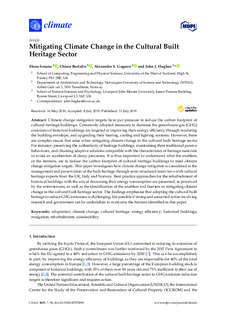| dc.contributor.author | sesana, elena | |
| dc.contributor.author | Bertolin, Chiara | |
| dc.contributor.author | Gagnon, Alexandre S. | |
| dc.contributor.author | Hughes, john | |
| dc.date.accessioned | 2019-11-07T13:05:59Z | |
| dc.date.available | 2019-11-07T13:05:59Z | |
| dc.date.created | 2019-09-18T11:36:59Z | |
| dc.date.issued | 2019 | |
| dc.identifier.citation | Climate. 2019, 7 (7), 90-113. | nb_NO |
| dc.identifier.issn | 2225-1154 | |
| dc.identifier.uri | http://hdl.handle.net/11250/2627227 | |
| dc.description.abstract | Climate change mitigation targets have put pressure to reduce the carbon footprint of cultural heritage buildings. Commonly adopted measures to decrease the greenhouse gas (GHG) emissions of historical buildings are targeted at improving their energy efficiency through insulating the building envelope, and upgrading their heating, cooling and lighting systems. However, there are complex issues that arise when mitigating climate change in the cultural built heritage sector. For instance, preserving the authenticity of heritage buildings, maintaining their traditional passive behaviours, and choosing adaptive solutions compatible with the characteristics of heritage materials to avoid an acceleration of decay processes. It is thus important to understand what the enablers, or the barriers, are to reduce the carbon footprint of cultural heritage buildings to meet climate change mitigation targets. This paper investigates how climate change mitigation is considered in the management and preservation of the built heritage through semi-structured interviews with cultural heritage experts from the UK, Italy and Norway. Best-practice approaches for the refurbishment of historical buildings with the aim of decreasing their energy consumption are presented, as perceived by the interviewees, as well as the identification of the enablers and barriers in mitigating climate change in the cultural built heritage sector. The findings emphasise that adapting the cultural built heritage to reduce GHG emissions is challenging, but possible if strong and concerted action involving research and government can be undertaken to overcome the barriers identified in this paper. | nb_NO |
| dc.language.iso | eng | nb_NO |
| dc.publisher | MDPI | nb_NO |
| dc.rights | Navngivelse 4.0 Internasjonal | * |
| dc.rights.uri | http://creativecommons.org/licenses/by/4.0/deed.no | * |
| dc.title | Mitigating Climate Change in the Cultural Built Heritage Sector | nb_NO |
| dc.type | Journal article | nb_NO |
| dc.type | Peer reviewed | nb_NO |
| dc.description.version | publishedVersion | nb_NO |
| dc.source.pagenumber | 90-113 | nb_NO |
| dc.source.volume | 7 | nb_NO |
| dc.source.journal | Climate | nb_NO |
| dc.source.issue | 7 | nb_NO |
| dc.identifier.doi | 10.3390/cli7070090 | |
| dc.identifier.cristin | 1726132 | |
| dc.description.localcode | © 2019 by the authors. Licensee MDPI, Basel, Switzerland. This article is an open access article distributed under the terms and conditions of the Creative Commons Attribution (CC BY) license (http://creativecommons.org/licenses/by/4.0/). | nb_NO |
| cristin.unitcode | 194,61,55,0 | |
| cristin.unitname | Institutt for arkitektur og teknologi | |
| cristin.ispublished | true | |
| cristin.fulltext | original | |
| cristin.qualitycode | 1 | |

